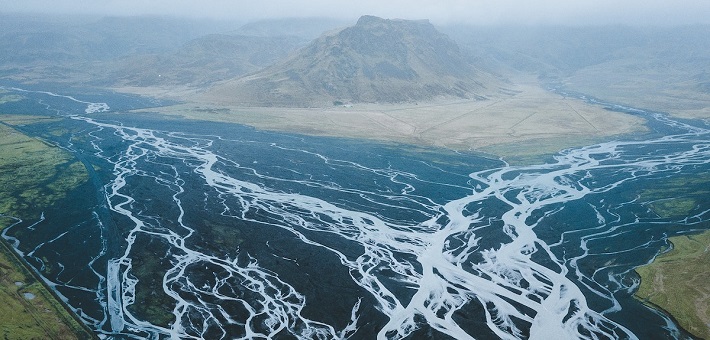Commentary on Luke 3:15-17, 21-22
What role might the actions of posing questions, nurturing kinship connections, and praying around water play in this moment of our Christian year and at the beginning of the new calendar year?
Luke’s account of baptism, starring both John the Baptist and Jesus, invites just such a moment of pause and reflection. It links the story of Jesus’s baptism with the stories of others, some of whom are named, and many who are not.
If one is reading straight through the Gospel of Luke, by this moment in the story, to reference John the Baptist is to allude to the story of his parents, Zechariah and Elizabeth (Luke 1:5-25, 57-80). Likewise, to reference Jesus is to allude to the stories of his parents, Mary and Joseph (1:26-38; 2:1-52). Similarly, as John and Jesus are coupled in this baptism story of questions, family, and water; their pairing alludes to the kinship and sisterhood of their mothers, Elizabeth and Mary. Before John and Jesus shared the stage in their collective moment of divine encounter and recognition, Elizabeth and Mary shared a similar moment of questions, affirmation, and celebration (2:39-56). Three chapters into the Gospel of Luke, the story of John and Jesus invites us, as readers of the gospel, to wonder, why is this baptism both vaguely repetitive and familiar and why is it inventive and new?
Moreover, running like a silver thread through all these interlinking stories are the divine encounters (theophanies) that produce questions, nurture kinships, and offer assurance for the unknown future. First, Zechariah has a divine encounter in the temple (1:8-21) and is inspired by spiritual reflection and recognition (1:67-79). Second, Elizabeth also had a moment of spiritual deliberation and appreciation (1:24-25). Third, Mary, has a theophany (1:26–38) and her own moment of assurance and celebration mediated by Elizabeth (1:46-55). We are even introduced to other divine encounters and moments of recognition occurring with working people like the shepherds (2:8-20) and the seers Simeon (2:25-32) and Anna (2:36-38). The latter are not minor characters, but exemplars of the interconnected and broad ripples of questions, encounters, and pronouncements operating as standard features of the story by the time we reach John’s proclamation, “I baptize you with water, but he who is mightier than I is coming…” (3:16).
In the story of Jesus’ baptism, water is both a site of religious activity as well as a topic of theological discourse and spiritual experience. Three points are worth noting about the thematic workings of questions, kinship, and water in today’s passage.
- Let them ask! Luke 3:15-22 opens describing “the people,” not John or Jesus. Those observing John’s actions asked questions filled with expectation and introspection. In the gospel of Luke, the Greek term, prosdokaō, means waiting, expecting, and giving thought to something that is, yet, unknown or manifest. It is to look toward future possibilities with either fear (Acts 27:33), longing (Luke 8:40; Acts 10:24), or even a neutral state of mind (2 Pet 3:12-14).
In Luke’s gospel, the action of waiting and expecting is frequently deployed as the posture of a general group, like the unnamed crowds or unnamed disciples of John the Baptist. They are not passive observers. Rather, they are active participants in the episodes in which they are featured. They often advance the storyline with their own questions and musings. For example, in the story of Zechariah, the general populace was waiting expectantly for his timely exit from the temple, and they noticed when it did not occur.
Their waiting expectation marked the passing of time in the story. Similarly, in another John and Jesus episode, some messengers approached Jesus saying, “John the Baptist has sent us to you to ask, ‘Are you the one who is to come, or are we to wait for another?’” Luke 7:19-20).
Group questions in the Gospel of Luke are not a sign of doubt, faithlessness, or even ignorance. Rather, it represents a collective participation and interest in the current moment of God’s revelation and action. With its initial focus on the people’s expectation and questions, Luke 3:15 highlights the important role of our faith communities’ questions. It is a tool for discerning the movements and messages of Spirit and faith in our contemporary time.
- Don’t confuse the roles! Another important element of the baptism story is the distinction made between Jesus and John. The Synoptic gospels emphasize the related, but distinct roles between Jesus and John (Luke 3:16-18; Matt 3:11-12; Mark 1:7-8), but only Luke develops the family ties and overlapping stories of the two figures. Luke 3:16-18 deploys a series of pictorial contrasts or metaphors to depict the distinct roles, which are: (1) a baptism of tangible water contrasted to an intangible baptism of Spirit and fire; (2) wheat contrasted to chaff; and (3) a series of minor images that include a winnowing fork, threshing floor, and a granary.
In terms of the first contrast (baptism of water versus baptism of Spirit-fire), scholars have offered a variety of interpretations. For example, some understand the fire as an image for the purifying work of God’s spirit. Others, make a different translation decision, translating Spirit into “wind.” In this interpretation, the saying, “He will baptize you with the Holy Spirit and fire,” foreshadows the windy and fiery showcase of the Holy Spirit in the Pentecost episode (Acts 2). Another interpretation juxtaposes the repentant versus unrepentant posture. From this reading, the end of days (or eschatological moment) marks the great separation or decoupling of repentant people (those purified by God’s fire) from unrepentant people (those unrefined by God’s fire).
Verse 17 leverages the agricultural context of John and Jesus, placing us at a harvest moment. Imagine a farmer with a pitchfork in her hand as she throws the grain up in the air, letting the wind assist in the sifting process. The wind blows the lighter fibers (“the chaff”) from the pile of grain, which drops, because of its weightiness, to the floor in front of her. Her process creates two separate piles. The first pile is composed of the weighted grain, which is a useful food and textile resource. The second pile is composed of the lightweight fibers blown all over the floor and in need of collection. From today’s passage, this sorting technique had already occurred. Now, the task before the farmer is to gather them in two different places—namely, the grain goes to the granary for storage and the chaff to the refinery for burning. In other words, in Luke’s account, baptism is not cast as the sifting process; but as a moment after the initial sifting when the relocation process is commencing.
- Prayerful stillness. Luke narrates a four-part baptism sequence in which (1) the people who asked questions were baptized, followed by (2) Jesus’ baptism, and (3) his prayerful moment, accompanied by (4) a visual and auditory revelation. Luke does not describe the form of baptism, only that Jesus and the people were baptized. Similarly, we are not told what Jesus prayed, only that he prayed immediately after baptism. Nonetheless, Jesus’ prayer is a uniquely Lucan detail because neither Matthew nor Mark report it (Matthew 3:13-17; Mark 1:9-11).
What is the purpose of prayer in Luke’s baptism story? Perhaps, Howard Thurman offers an insight in his meditation called, “Who, or What, is to Blame?” when he says, “Through prayer, meditation, and singleness of mind, the individual’s life may be invaded by strength, insight, and courage sufficient for his needs” (Thurman, Meditations of the Heart).
Today’s passage is a Gospel story for which seasoned lectionary preachers are familiar. We are challenged, therefore, to try to read it with fresh insights and interpretive possibilities for our communities’ present and future moments. Instead of simply retelling the story of Jesus’s baptism, we can use it as an opportunity to narrate the matrix of stories constituting the subtext of this Jesus-John episode. Using it as a foundation, we can invite our hearers to consider the matrix of family stories and questions that they carry into the new experiences of faith awaiting us this calendar year. Secondly, the passage creates the opportunity to embrace the necessary and generative work of our faithful ponderings. The questions of our congregations, families, friends, and institutions can contribute to our spiritual encounters and faithful work in the world. It can be a tool that moves us closer to God’s spirit, preparing us for any number of sensory experiences of the divine. It also can be an instrument for expanding our faith communities in the work of our hearts, heads, and hands.


January 9, 2022